
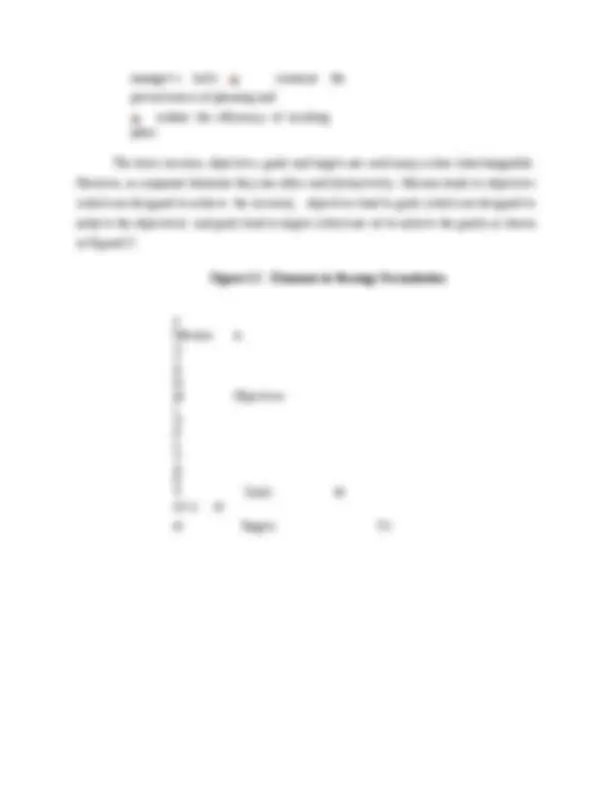
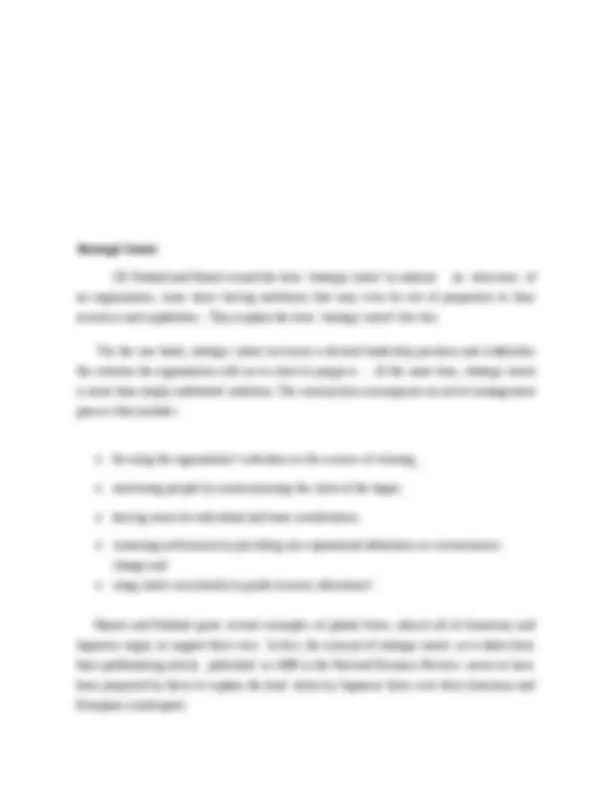
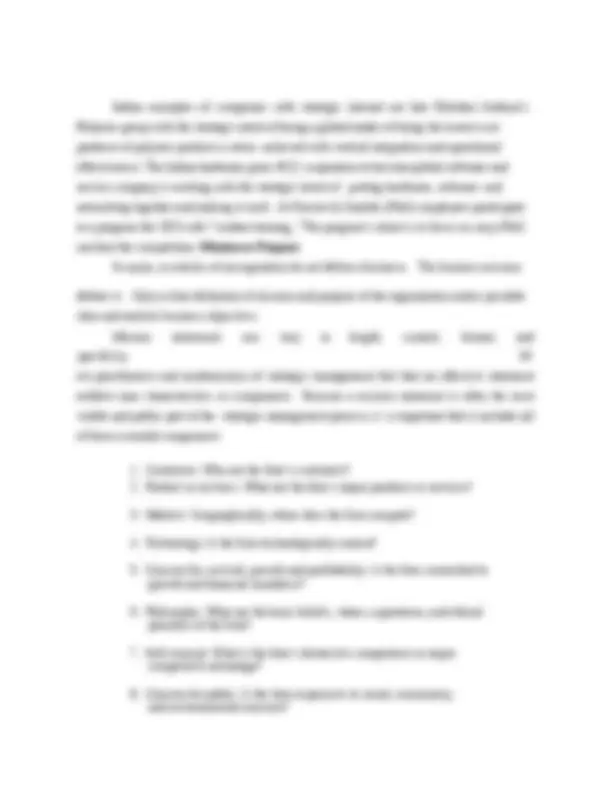
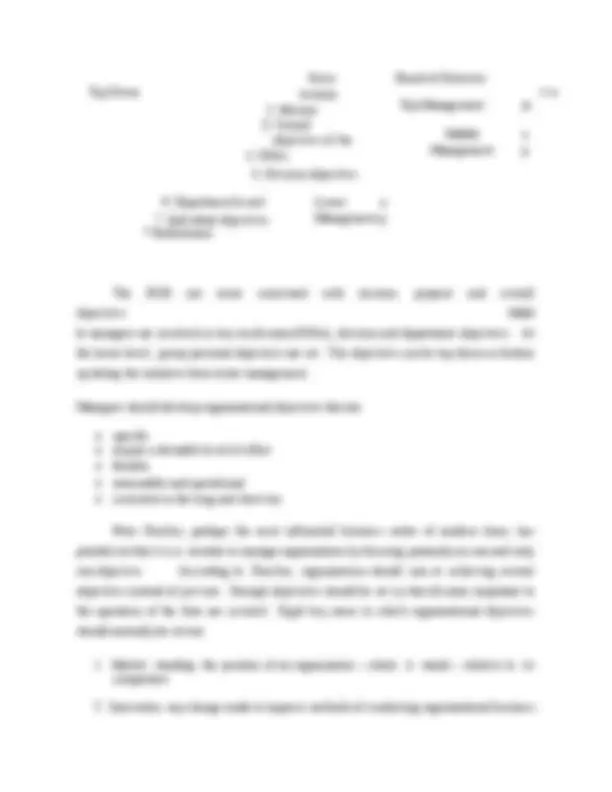

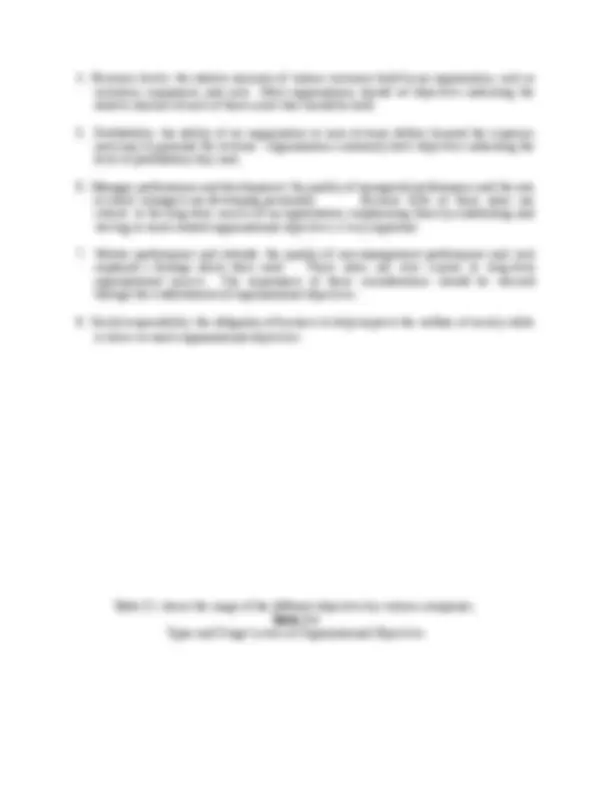



Study with the several resources on Docsity

Earn points by helping other students or get them with a premium plan


Prepare for your exams
Study with the several resources on Docsity

Earn points to download
Earn points by helping other students or get them with a premium plan
Community
Ask the community for help and clear up your study doubts
Discover the best universities in your country according to Docsity users
Free resources
Download our free guides on studying techniques, anxiety management strategies, and thesis advice from Docsity tutors
Establishing, Selecting Missions, Contribute Primarily To Manager’s Purpose, Distinctively, Strategic Intent, Contributions, Pathbreaking, Hcl, Strategic Management, Customers, Technologically Current, Environmentally, Establishing, Specific, Flexible, Measurable, Consistent In The Long And Short Run, Mistake, Conducting Organizational Business
Typology: Study notes
1 / 13

This page cannot be seen from the preview
Don't miss anything!








Planning is way of organization life but it differs from individuals to organizations. It is futuristic, decision oriented and goal driven. Planning bridges the gap from where we are to where we want to go. It involves the process of establishing direction, identifying a strategic intent, selecting missions and objectives and ways of achieving them.
Process of establishing organizational direction The process of establishing direction consists of three major step as shown in Figure 3.1 (1) Reflecting on the results of an environmental analysis, (2) Establishing an appropriate organizational mission, and (3) Establishing appropriate organizational objectives. Figure 3.1 Strategic Management –Process focus
MISSION Great Scot
LONG-RUN OBJECTIVES F 04 6Make
SHORT-RUN OBJECTIVES F 04 6 Achieve
Supermarkets is a progressiv e growth
Serves as foundation for..
When accomplis- hed result in the accomplish
Great Scot above the grocery store industry average profitabili ty
F 04 6Improve competiti ve position within market areas.
Serves as foundation for..
When accomplis- hed result in the accomplish
major reductions in F 0 wage expenses 4 6 Reduce warehouse expenses F 04 6 Buy quality products at lower costs F 04 6 Review and evaluate sales run by competition. F 04 6 Match prices offered by competition on high- volume items F 04 6 Encourage store tours by community
Source: Samuel C. Certo & J Paul Peter, Strategic Management – A Focus on Process, Mc Graw Hill International, New York. p
Developing mission and objectives helps a manager
contribute primarily to manager’s purpose identify primarily among
Strategic Intent
CK Prahald and Hamel coined the term ‘strategic intent’ to indicate an obsession of an organization, some times having ambitions that may even be out of proportion to their resources and capabilities. They explain the term ‘strategic intent’ like this.
“On the one hand, strategic intent envisions a desired leadership position and establishes the criterion the organization will use to chart its progress…. At the same time, strategic intent is more than simply unfettered ambition. The concept also encompasses an active management process that includes:
o focusing the organization’s attention on the essence of winning, o motivating people by communicating the value of the target, o leaving room for individual and team contributions, o sustaining enthusiasm by providing new operational definitions as circumstances change and o using intent consistently to guide resource allocations”.
Hamel and Prahlad quote several examples of global firms, almost all of American and Japanese origin, to support their view. In fact, the concept of strategic intent –as evident from their pathbreaking article, published in 1989 in the Harvard Business Review- seems to have been proposed by them to explain the lead taken by Japanese firms over their American and European counterparts.
Indian examples of companies with strategic internet are late Dhirubai Ambani’s Reliance group with the strategic intent of being a global leader of being the lowest cost producer of polyster products a status achieved with vertical integration and operational effectiveness. The Indian hardware grint, HCL’s aspiration to become global software and service company is working with the strategic intent of putting hardware, software and networking together and making it work At Procter & Gamble (P&G) employees participate in a program the CEO calls “combat training, “The program’s intent is to focus on ways P&G can beat the competition. Mission or Purpose Its name, or articles of incorporation do not define a business. The business mission
defines it. Only a clear definition of mission and purpose of the organization makes possible clear and realistic business objectives. Mission statements can vary in length, content, format, and specificity. M ost practitioners and academicians of strategic management feel that an effective statement exhibits nine characteristics or components. Because a mission statement is often the most visible and public part of the strategic-management process, it is important that it includes all of these essential components:
Figure 3.3 Hierarchy of objectives
Top Down
Socio econom
Board of Directors t t o Top Management m Middle u Management p
Lower a Management p
The BOD are more concerned with mission, purpose and overall objectives. Midd le managers are involved in key result areas(KRAs), division and department objectives. At the lower level, group personal objectives are set. The objectives can be top down or bottom up taking the initiative from lower management.
Managers should develop organizational objectives that are
o specific o require a desirable level of effort o flexible o measurable and operational o consistent in the long and short run
Peter Drucker, perhaps the most influential business writer of modern times, has pointed out that it is a mistake to manage organizations by focusing primarily on one and only one objective. According to Drucker, organizations should aim at achieving several objectives instead of just one. Enough objectives should be set so that all areas important to the operation of the firm are covered. Eight key areas in which organizational objectives should normally be set are:
Table 3.1 shows the usage of the different objectives by various companies. Table 3- Types and Usage Levels of Organizational Objectives
Type of objective Number of companies studied having objective type
Percent of companies studied having objective type Profitability 73 89 Growth 67 82 Market share 54 66 Social responsibility 53 65 Employee welfare 51 62 Product quality and service
Research and Development
Diversification 42 31 Efficiency 41 50 Financial stability 40 49 Resource conservation 32 39
Management development
Multinational enterprise
Consolidation 14 17 Miscellaneous other goals
*Adds to more than 100 percent because most companies have more than one goal Source : Y.K. Shetty, New Look at Corporate Goals,” California Management Review, 22 , No.2 (Winter 1979).
achieving each of these objectives, an integrated approach to functional plans and policies would be necessary. For instance, a company, which intends to be a market leader, would have to offer products of the best quality at a competitive price through an efficient distribution network supported by an aggressive promotion policy. The other functional area plans and policies would have to supplement these marketing policies.
Summa ry
Two main organizational ingredients are commonly used to establish organizational direction: Organizational mission and organizational objectives. Organizational mission is the purpose for which, or reason why, the organization exists. An organizational mission should help focus human effort, ensure compatibility of organizational purposes, provide a rationale for resource allocation, indicate broad areas of job responsibility, and provide the foundations for organizational objectives. Objectives are the end points of an activity. They help define the direction of an organization in concrete form for accomplishment. Objectives of an organization form a hierarchy and are multiple. Objectives are needed in key result areas. They include market-standing, innovation, productivity, profitability, public responsibility, physical and financial resources, employee performance and attitude and manager performance and development. Synergy is necessary for competitive advantage. For instance, a company, which intends to be a market leader, would have to offer products of the best quality at a competitive price through an efficient distribution network supported by an aggressive promotion policy. The other functional area plans and policies would have to supplement these marketing policies.